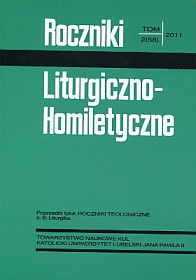The Importance of the First Sentence, or How to Start a Sermon
Abstract
Contemporary preaching practice stresses the importance of very well prepared introduction, which structures the sermon, making it clear and transparent. It also facilitates communication between the speaker — the preacher, and the recipients — the listeners.
The purpose of this article is to attempt a critical look at the introductions of contemporary sermons in the light of guidelines, which for this important part of the text were outlined by philosophers of ancient rhetoric and preaching. Deliberation presented in this article is the result of much discussion regarding the practical realization of the principles of composition of the introduction. Material submitted for analysis of preaching style comes from “The Radio Sermons of the Holy Cross Church in Warsaw” collections. The intention of this article’s author is to inspire preachers to reflect on the construction process of the introduction in their unique sermons and homilies. An ingenious preacher’s main responsibility is to surprise his listeners, to waken their interest, to free them from everyday routine from the beginning, so that in the end, they will be inspired to reach for supernatural reality and be led to God.
References
Corbett E.P.J., Connors R.J.: Classical Rhetoric for the Modern Student. New York–Oxford 1999.
Hamlin S.: Jak mówić żeby nas słuchali. Warszawa 2001.
Kohout J.: Retoryka. Mowa zjednuje ludzi. Wyd. IV. Gliwice 2006.
Korolko M.: Sztuka retoryki. Warszawa 1990.
Koziara S.: Status i funkcja form adresatywnych w języku współczesnych kazań. W: Fenomen kazania. Red. W. Przyczyna. Kraków 1999 s. 136-145.
Krótko i ku chwale bożej. Wywiad z ks. E. Burzykiem. „Gazeta Wyborcza” nr 51, wydanie z 29.02.2008 s. 12
Lemmermann H.: Komunikacja werbalna. Szkoła retoryki. Wrocław 1997.
Lemmermann H.: Komunikacja werbalna. Sztuka dyskutowania: techniki argumentacji, dyskusje, dialogi. Wrocław 1997.
Łyko Z.: Homiletyka współczesna. Warszawa 1990.
Miodek J.: Współczesne kaznodziejstwo polskie. W: Tysiąc lat polskiego słownictwa religijnego. Red. B. Kreja. Gdańsk 1999 s. 265-272.
Panuś K.: Sztuka głoszenia kazań. Kraków 2008.
Pisarek W.: Retoryka dziennikarska. Kraków 1975.
Sieradzka-Mruk A.: Sytuacja komunikacyjna jako czynnik organizujący tekst kaznodziejski. W: Retoryka dziś. Teoria i praktyka. Red. R. Przybylska, W. Przyczyna. Kraków 2001 s. 313-321.
Siwek G.: Przepowiadać skuteczniej. Elementy retoryki kaznodziejskiej. Kraków 1992.
Siwek G.: Dialog w głoszeniu Słowa Bożego. „Biblioteka Kaznodziejska” 2007 nr 2 (151) s. 9-17.
Zerfass R.: Od aforyzmu do kazania. Kraków 1995.

